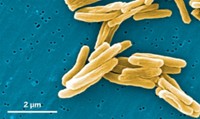Advertisement
Grab your lab coat. Let's get started
Welcome!
Welcome!
Create an account below to get 6 C&EN articles per month, receive newsletters and more - all free.
It seems this is your first time logging in online. Please enter the following information to continue.
As an ACS member you automatically get access to this site. All we need is few more details to create your reading experience.
Not you? Sign in with a different account.
Not you? Sign in with a different account.
ERROR 1
ERROR 1
ERROR 2
ERROR 2
ERROR 2
ERROR 2
ERROR 2
Password and Confirm password must match.
If you have an ACS member number, please enter it here so we can link this account to your membership. (optional)
ERROR 2
ACS values your privacy. By submitting your information, you are gaining access to C&EN and subscribing to our weekly newsletter. We use the information you provide to make your reading experience better, and we will never sell your data to third party members.
Analytical Chemistry
New Portable Kit Detects Arsenic In Wells
Water Testing: Field tests show the measurements are quicker than commercially available arsenic kits
by Katharine Sanderson
February 24, 2012

An easy-to-use, portable test to detect and quantify arsenic in water wells has been successfully tried out in Bangladeshi villages (Environ. Sci. Technol., DOI: 10.1021/es203511k). The kit worked as well as commercially available tests. Its developers say it could help villagers quickly and easily determine which wells contain safe drinking water.

Arsenic-contaminated drinking water is a global problem that particularly affects Bangladesh. Some 80% of the country’s drinking-water wells aren’t tested for arsenic even though levels of the poisonous element vary widely even in a single village (Environ. Health, DOI: 10.1186/1476-069X-11-7). Hauke Harms at the Helmholtz Center for Environmental Research in Leipzig, Germany, and his colleagues wanted to make a test kit that would be easier to use and more portable than commercially available ones.
Their test uses technology they previously developed: genetically engineered Escherichia coli bacteria, whose natural arsenic-detecting defense gene turns on an added gene for a luminescent enzyme. When arsenic invades the cell, the engineered bacteria glow in proportion to the quantity of arsenic.
In the test, researchers inject well samples into sealed vials containing freeze-dried bacteria and then shake the vials. Two hours later, a luminometer reveals the amount of arsenic in each sample. The team developed a test kit that contains 150 vials and easily fits in a backpack.
Two commercial kits, the Arsenator and the Merckoquant, use a chemical technique: Arsenic in water reacts with a test reagent to produce arsine gas. A color-changing strip reveals the quantity.
Harms tested all three kit types in six Bangladeshi villages in 2010. The researchers found that a person using the commercial kits could test 60 samples per day, while a person using the new kits could test 150. “Our kit is much easier to use,” Harms says, and gives quantitative results. It took him a few hours to train local people to use his test. The biosensor test also is less bulky and produces less waste than the two other kits, Harms says.
The Bangladeshi government sets safe levels at below 50 ppb. All three tests could distinguish between wells above and below that level and could detect arsenic down to about 4 ppb. The World Health Organization’s safety level is just 10 ppb, but very few wells in Bangladesh have such low levels (Bull. World Health Organ., 2000, 78, 1093).
Chris French of the University of Edinburgh, praises Harms’s kit, calling it “a big step” toward a biosensor kit that can be used in the field. He notes that researchers have been looking forward to such kits because they expect the biosensors to be highly sensitive and inexpensive.
Harms and his group make the kits by hand at a cost of about $1.30 per test, about twice the cost of commercial kits. He hopes that the price will come down with mass production, and that nonprofit groups will donate luminometers to villages. Because the kit uses genetically modified organisms, Harms needs governmental permission to distribute it in Bangladesh, a process he expects to take months.
Lex Van Geen, of Columbia University, is in Bangladesh testing other chemical kits. He welcomes the biosensor test and stresses the urgent need for testing: “The single most important reason a large proportion of people are exposed to arsenic is because they don’t know the status of their well,” he says.





Join the conversation
Contact the reporter
Submit a Letter to the Editor for publication
Engage with us on Twitter